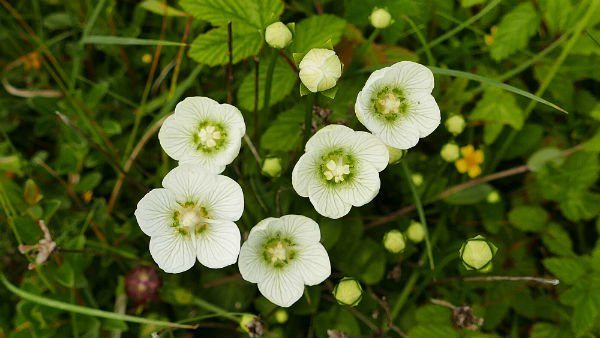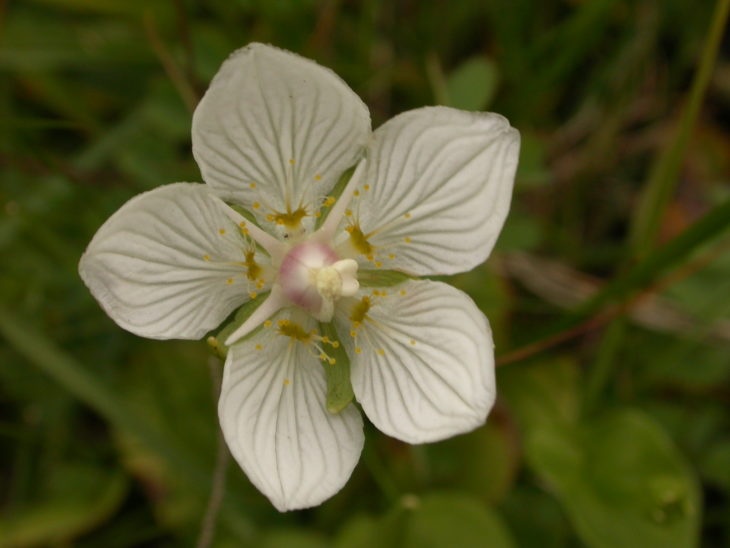Grass of Parnassus – enigmatic and misnamed?
Dr Deborah Long introduces the sophisticated charms of grass of Parnassus, one of the Trust’s Priority Species, and outlines how people can help conserve this unassuming plant that thrives in damp spaces.
A native of the wild and wet, grass of Parnassus is not for the unadventurous. Explore the wet pastures and moorlands of Sutherland, the damp grasslands and roadsides of Argyll, or the Hebridean machair in July or August and you’ll find it. From a distance it is an unremarkable single flower that only grows to about 25 cm, but get up close and you appreciate the sophisticated charm of this beautiful plant.

Its cupped white petals laced with translucent green veins surround the gold stigma and stamens, producing a fresh beauty worthy of the coolest Scandinavian design schemes. Its understated charm, and the fact it grows in these amazing places, makes this one of my favourite plants.
Its Latin name Parnassia palustris conjures up much more sunlit habitats but while it does grow in the Greek mountains, it is actually rare in the south of Europe. It is much more a plant of the northern regions and although it was once common through the UK it is now restricted to Scotland, northern England and north Wales. When it was named by Linnaeus he may have been making a link between the beauty of the flower and the home of Apollo.
Its Latin name conjures up much more sunlit habitats but while it does grow in the Greek mountains, it is actually rare in the south of Europe
More than that, the plant has inspired poetry – the poet Andrew Lang describes its habitat in Galloway and its evocative signal for autumn. Indeed, this is where the much more practical Swedish name for the plant comes from. Slåtterblomma, meaning hay-making flower – was the signal to bring in the harvest.
Grass of Parnassus also has medicinal qualities. Plants for A Future describes its medicinal uses, including as a mouthwash to treat stomatitis, distilled as an eye lotion, and dried and then powered to treat wounds. Other references indicate it was once used to treat disorders of the liver. An infusion of the leaves was used to treat indigestion and when added to wine or water, the leaves are claimed to dissolve kidney stones.
However, there are no recorded uses for grass of Parnassus in Scotland to be found in any of my ‘go to’ references for plant use in Scotland: Tess Darwin’s A Scottish Herbal, Milliken and Bridgewater’s Flora Celtica, and Mary Beith’s Healing Herbs. As a fairly frequent and easily found plant, I’m pretty sure it would have been used.
It’s another reason why I find this plant so intriguing: there is more to re-discover about it. As with so many native plants, our links to them in terms of value and use are being lost.

Conservation status
Despite being easy to find in the right habitat in Scotland and northern England, its rarity further south is due more to habitat change rather than a lack of suitable habitat. Drainage, eutrophication and the succession of fenland has led to its decline.
Grass of Parnassus is listed as Least Concern in the IUCN Red List and on the UK Red List because it is widespread with stable populations in parts of its range, which means the risk of it going extinct in Europe is considered low. It is nonetheless continuing to decline and in some parts of Europe it is classed as threatened. As such, local conservation measures are required.
Even in the UK where grass of Parnassus is still relatively widespread in the north, the species has continued to show a marked decline in the southern part of its range. This is attributed to land drainage. In the north and north west of Britain and in Ireland, it appears to be stable. However, the reason for the lack of records for the plant in northern Scotland are not clear (Online Atlas for the British and Irish Flora).
Conservation measures are key to prevent its range contracting further. These are conservation actions rooted in habitat management and protection. Unless we retain and manage the habitats it needs, the species will continue to decline. Alongside the other plants it is often found with – autumn hawkbit, bog pimpernel, meadowsweet, red cover, rough hawkbit, and yellow iris – it needs damp and open non-wooded sites. Maintaining wet pastures and preventing drying out and scrub encroachment is vital.
This means active management of the machair: grazing, especially by cattle, is key to maintain its wet pasture habitat. Similarly in wet moorland and bogs, maintaining water levels and preventing overgrazing by sheep and deer is also crucial. The differentiation in grazing animals is important, as sheep and deer often target flowers but cattle are generally less choosy. Bringing cattle back into sites can help a range of threatened plant species and the benefits are numerous.
Help save grass of Parnassus
Even if you don’t manage a grassland, machair or bog, there are a few things you can do. Top of the list is to notice the plant and help increase the number of records we have. As an easy plant to identify all records are helpful – submit them via i-Record and the National Biodiversity Network to help build up the database of this species. Secondly, keep an eye on local sites. If you see scrub encroachment or drainage, let the land owner know where grass of Parnassus grows, and what conditions it needs.
If you have a garden, you could grow it in a wet patch with the correct soil conditions (permanently damp, on the alkaline side). It can be grown from seed as it is hermaphrodite and produces nectar to attract pollinating insects. Never dig up the plant but try to find some seed, which it produces readily, and see if you can grow it from there.
Most importantly, enjoy it. Celebrate when you find it. And see what it inspires you to do.
Dr Deborah Long is Programme Director of the GROW Observatory
Help protect Scotland’s wildlife
Our work to save Scotland’s wildlife is made possible thanks to the generosity of our members and supporters.
Join today from just £3 a month to help protect the species you love.
Preface
Dr Deborah Long introduces the sophisticated charms of grass of Parnassus, one of the Trust’s Priority Species, and outlines how people can help conserve this unassuming plant that thrives in …
